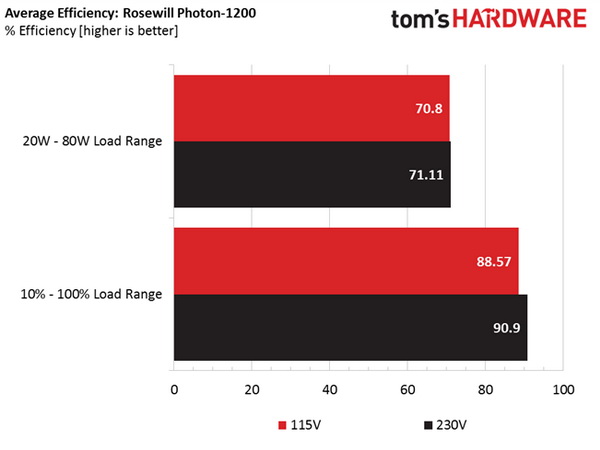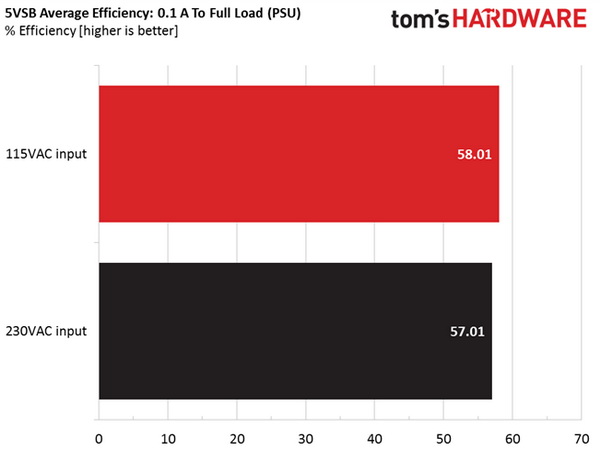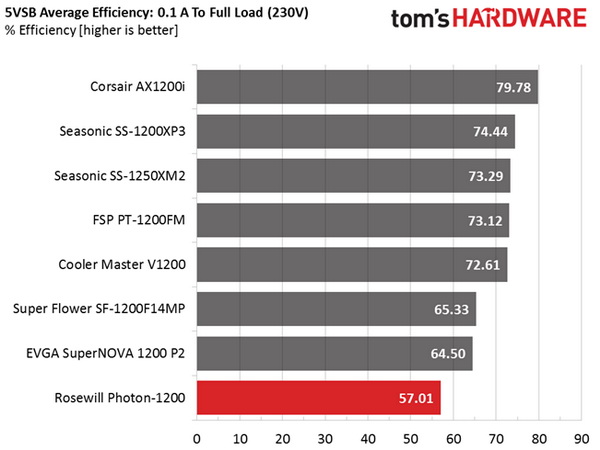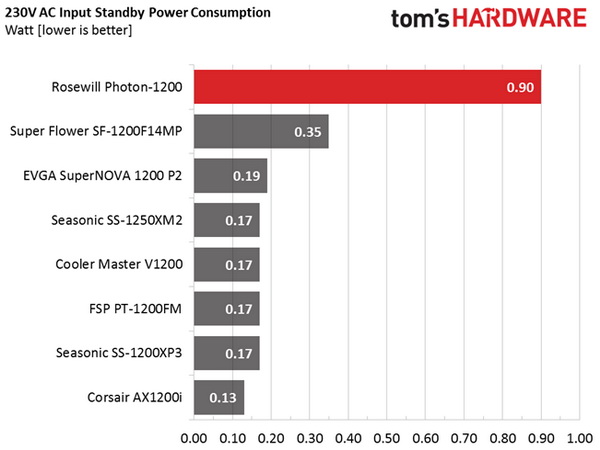Rosewill Photon-1200 PSU Review
Today, we evaluate Rosewill's Photon-1200, manufactured by Sirfa, featuring fully modular cabling, Gold-rated efficiency and a high watt-per-dollar ratio.
Why you can trust Tom's Hardware
Efficiency, Temperature And Noise
Efficiency
Our efficiency testing procedure is detailed here.
Using the previous page's results, we plotted a chart showing the Photon-1200's efficiency at low loads, and loads from 10 to 110 percent of the PSU's maximum-rated capacity.




The Photon-1200 isn't very efficient under light and normal loads, at least not for a Gold-rated PSU. This is something we expected, given the outdated platform. If you need higher efficiency and less noise, you'll have to spend more money.
Efficiency At Low Loads
In the following tests, we measure the efficiency of the Photon-1200 at loads significantly lower than 10 percent of the device's maximum capacity (the lowest load the 80 PLUS standard measures). The loads we dialed were 20, 40, 60 and 80W. This is important for representing when a PC is idle, with power-saving features turned on.
| Test # | 12 V | 5 V | 3.3 V | 5 VSB | Power(DC/AC) | Efficiency | Fan Speed | Fan Noise | PF/AC Volts |
|---|---|---|---|---|---|---|---|---|---|
| 1 | 1.181A | 0.481A | 0.472A | 0.189A | 19.60W | 50.98% | 1580 RPM | 54.2 dB(A) | 0.913 |
| 12.316V | 5.172V | 3.373V | 5.163V | 38.45W | 115.1V | ||||
| 2 | 2.394A | 0.958A | 0.977A | 0.386A | 39.71W | 70.87% | 1580 RPM | 54.2 dB(A) | 0.969 |
| 12.311V | 5.170V | 3.371V | 5.156V | 56.03W | 115.1V | ||||
| 3 | 3.609A | 1.455A | 1.481A | 0.580A | 59.91W | 79.27% | 1580 RPM | 54.2 dB(A) | 0.947 |
| 12.307V | 5.168V | 3.369V | 5.149V | 75.58W | 115.1V | ||||
| 4 | 4.811A | 1.931A | 1.957A | 0.775A | 79.74W | 82.10% | 1610 RPM | 54.9 dB(A) | 0.913 |
| 12.302V | 5.167V | 3.368V | 5.142V | 97.13W | 115.1V |
Efficiency under light loads is mediocre. However, that's not the only bad thing about this unit. If you take a look at the fan noise column in the table above, you will see that its biggest weakness is noise, again, even under very light loads. We should note that we tested at an ambient temperature around 40 °C. Still, we expected much lower noise levels in this section.
5VSB Efficiency
The ATX specification states that 5VSB standby supply efficiency should be as high as possible, recommending 50 percent or higher efficiency with 100mA of load, 60 percent or higher with 250mA of load and 70 percent or higher with 1A or more of load.
We will take four measurements: one each at 100, 250 and 1000mA, and one with the full load the 5VSB rail can handle.
Get Tom's Hardware's best news and in-depth reviews, straight to your inbox.
| Test # | 5VSB | Power (DC/AC) | Efficiency | PF/AC Volts |
|---|---|---|---|---|
| 1 | 0.101A | 0.51W | 34.00% | 0.174 |
| 5.073V | 1.50W | 115.1V | ||
| 2 | 0.252A | 1.28W | 52.25% | 0.233 |
| 5.069V | 2.45W | 115.1V | ||
| 3 | 1.002A | 5.06W | 69.70% | 0.329 |
| 5.047V | 7.26W | 115.1V | ||
| 4 | 4.003A | 19.81W | 76.10% | 0.401 |
| 4.948V | 26.03W | 115.1V |


Efficiency on the 5VSB rail is just terrible. We strongly believe that high vampire power consumption is the cause of this rail's poor efficiency.
Power Consumption In Idle And Standby
| Mode | 12V | 5V | 3.3V | 5VSB | Power (AC) | PF/AC Volts |
|---|---|---|---|---|---|---|
| Idle | 12.321V | 5.173V | 3.374V | 5.173V | 26.50W | 0.891 |
| 115.1V | ||||||
| Standby | 0.88W | 0.115 | ||||
| 115.1V |


In the table above, you'll find the power consumption and voltage values of all rails (except -12V) when the PSU is idle (powered on, but without any load on its rails), and the power consumption when the PSU is in standby mode (without any load, at 5VSB).
Phantom power is well above 0.5W, meaning that this unit isn't ErP Lot 6 2013-compliant. However since it isn't sold in the EU, it doesn't have to be. Nonetheless, the less power wasted, the better. And in this case, increased power consumption at standby leads to poor 5VSB efficiency as well.
Fan RPM, Delta Temperature And Output Noise
Our mixed noise testing is described in detail here.
The first chart below illustrates the cooling fan's speed (RPMs), and the delta between input and output temperature. The results were obtained at 40 °C (104 °F) to 49 °C (120.2 °F) ambient temperature.
The next chart shows the cooling fan's speed (RPMs) and output noise. We measured acoustics from one meter away inside of a small, custom-made anechoic chamber with internals completely covered in sound-proofing material (be quiet! Noise Absorber kit). Background noise inside the anechoic chamber was below 18 dB(A) during testing, with ambient temperature at the levels noted above.


The following chart illustrates the fan's output noise over the entire operating range of the PSU. The same conditions of the above graph apply to our measurements, though the ambient temperature was between at 28 °C (82.4 °F) to 30 °C (86 °F).
Even with normal operating temperatures the Photon-1200 is noisy. Rosewill and Sirfa should offer a more relaxed fan profile, especially at lower loads. If you want to build a silent PC, you should refrain from buying this PSU.
Current page: Efficiency, Temperature And Noise
Prev Page Load Regulation, Hold-Up Time And Inrush Current Next Page Cross-Load Tests And Infrared Images
Aris Mpitziopoulos is a contributing editor at Tom's Hardware, covering PSUs.
-
MasterMace Sirfa has produced too many poor units in the past to get any leeway or benefit of the doubt. It failed 80 Plus Gold in the hotbox at 100% load.Reply -
boller I have a good perspective on that ripple thing: just finished repairs of a PC power supply and when I was measuring ripple I found it was out of whack (300 mV pp). After some investigation I found out that measuring ripple is a tricky thing. Tom's description on how they do it is very incomplete. Eevblog guy spent an entire episode on ripple. In my case I had to do this: limit oscilloscope bandwidth 20 MHz, instead of the grounding clip use that spring attachment and measure loaded PSU at the last cap before leads. Ripple went down from 300 to 48 mV pp.Reply -
Aris_Mp First of all you don't just hook a scope on a PSU's output and measure ripple else you will catch huge spikes, like in your case, which will totally alter the measured result.Reply
Secondly most users aren't interested on how I do things (and even if I elaborated on all the procedures I follow only a fraction of them would understand them) but about the final result. For me the most important is to explain what ripple is and how it can affect the components of a system.
Thirdly. You don't have to watch Dave to see how ripple is measured properly. You can check on the ATX spec which includes the ripple measurement procedure. I follow all guidelines of the ATX spec so if you need to see how I measure ripple or load regulation just take a look at them. In any case the following scheme will show you how to measure ripple on a PSU.
-
boller No need to be defensive, I was just pointing out that your _description_ is incomplete, not that you do it wrong. Although it would be nice for you to place a note over there saying that actual procedure involves some additional caps and an honest to god differential probe (!)Reply -
Aris_Mp I just replied to your concerns. No need to think that I am defensive because clearly this is not the case with me.Reply
I already stated that I don't mention how I measure ripple since among others all of us reviewers have to follow the ATX spec procedure. There is no point in repeating the whole ATX spec from the moment that anyone can download and read this spec with a simple google search.
Besides these two caps (which are already pre-installed on the fixtures that most of us reviewers have. There also present on loaders like the Sunmoon ones) and the good quality probes you also need to isolate all external noise that can pass from the PSU's EMI filter. In other words you need to provide "clean" power to the PSU. Personally I do this with a Chroma AC source and in the near future I plan to get a online UPS with some extra circuits for EMI/noise protection which will feed the AC source (so I will have two layers of protection). In order to check if your line is clean firstly take some readings on the major rails (+12V, 5V and 3.3V) with the PSU in standby. If you see increased ripple (normally it should be close to zero mV) then your scope picks up noise or the PSU isn't properly isolated from the rest devices on your home/lab. -
CTurbo It's not a bad unit, but it's not competitive at all. It's more expensive than an EVGA G2 1300w Gold and and Rosewill Capstone 1200w Gold, and almost as much as an EVGA P2 1200w. Yikes!Reply -
Mac266 Shame it performed badly, a cheap high rated supply could stir the market up nicely!Reply
It's not a bad unit, but it's not competitive at all. It's more expensive than an EVGA G2 1300w Gold and and Rosewill Capstone 1200w Gold, and almost as much as an EVGA P2 1200w. Yikes!
CTurbo! How ya been mate?
